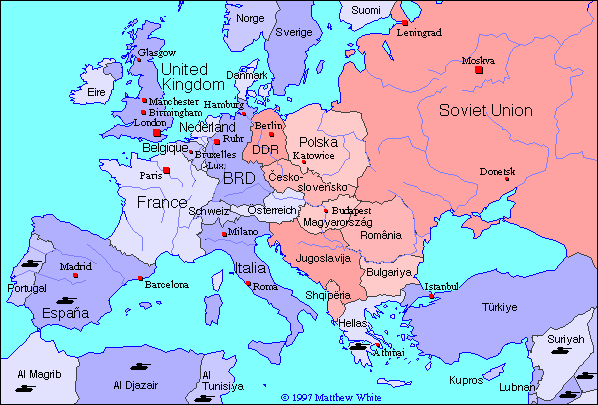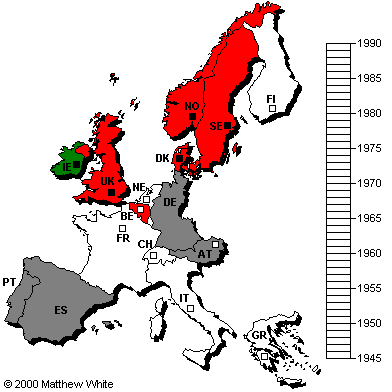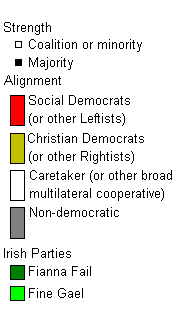


 |
 |
![]()

Obviously, trying to shoehorn every political faction of 16 countries across 45 years into four narrow categories ("left", "right", "both" and "neither") is a daunting task. Specific issues vary from country to country, so national parties coalesce or collapse based on local alliances and problems; however, the nations of West Europe haved shared a common religious, economic and philosophic heritage long enough for local differences to erode, and local parties have often evolved convergently. In fact, it's probably no coincidence that the two principle parties in many European states take their names from Socialism and Christianity, two deep-rooted and extremely evangelical philosophies which deliberately transcend narrow nationalism in favor of a larger community of believers.
Just for the record, these are the customary differences between Left and Right:
Of course, most people would probably consider all these principles to be good in moderation and bad in excess -- which explains why we have politics. It gives the collective community a chance to adjust the balance between contradictory virtues.
One further note: The dividing line between left and right is always relative, and each nation splits wherever the 50:50 line falls in local public opinion. Worldwide standards, however, are often quite different. Thus, in a nation like Italy, the principle parties might appear to an outsider as parties of the Left, the Far Left, the Really Far Left, and the Really Really Far Left. Meanwhile, the Democratic Party of the USA represents the left wing of American politics, but by world standards, it's a party of the Center-Right, and probably farther right than most Christian Democrats.
Most of these countries are model parliamentary governments where the Head of State (the monarch or president) is a ceremonial figurehead, and administrative policy decisions fall to the Head of Government (a prime minister representing the leading faction of the legislature). Therefore, it should be noted that whenever the Heads of State and Government are of different parties, I have illustrated the party of Government, not State. Even in France (probably the only country on this map with a strong president) during the years 1986-88 when the president and premier were of different parties, I have mapped the party of the premier.
The political parties in Ireland, the youngest of the West European states, are still extremely local in issues and orientation, and they don't quite fit the left/right mold. Neither of the two leading parties seems to have aligned itself against the other based on the above checklist of principles.
Switzerland, the oldest European democracy, leaves most policy decisions either to the citizenry as a whole, or to the individual cantons. Swiss political parties seem to exist as a mere formality, and positions in the national government are allocated according to an agreed ratio (the "magic formula" devised in 1959) rather than by competitive elections.
During the Cold War, the Soviet Union interfered in the politics of two former enemies:
Aside from the overtly authoritarian regimes of the Mediterranean, democracy was only threatened twice on the map
Recomended Reading: Walter Laquer, Europe Since Hitler : The Rebirth of Europe (1982)
Last Updated March 2000
Copyright © 1998-2000 Matthew White